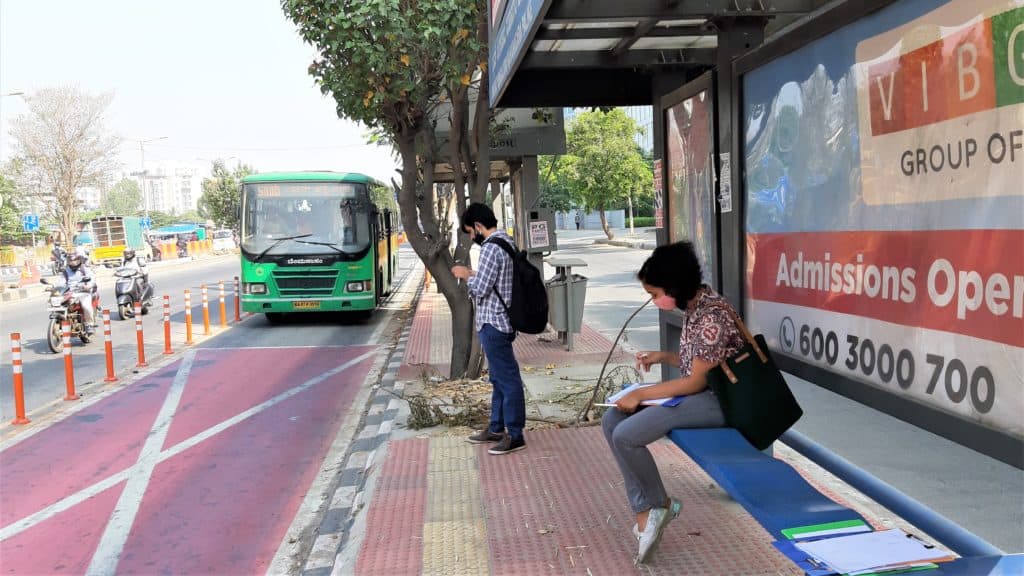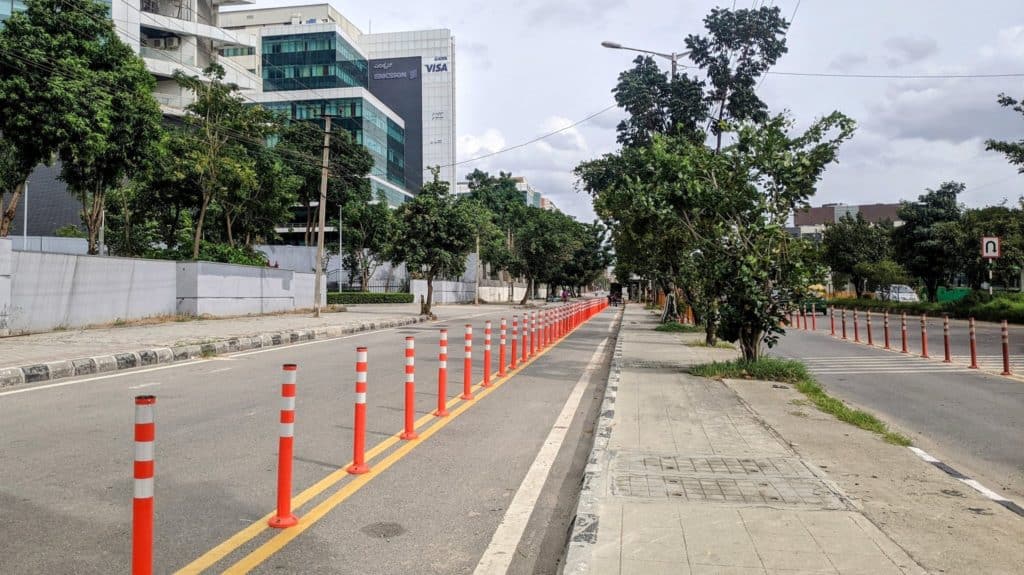This is the third of the three-part analysis of various mobility policies/plans for Bengaluru that aim to regulate the use of private vehicles to reduce road traffic congestion, improve public transport, and create the right infrastructure for non-motorised transport, particularly cycling and walking through the mobility intervention.
Given the problems and delays plaguing the expansion of the metro lines and suburban rail system, for Bengalureans, the city bus remains the only alternative to using personal vehicles. The financially troubled transport corporations are trying to augment their fleets and increase and improve services.
One aspect of these efforts has been the use of urban planning and design to make using the city bus more efficient. Creating the city’s first Bus Priority Lane(BPL), a commendable initiative of The Directorate of Urban Land Transport (DULT). The first such lane became operational in November 2019 between KR Puram and Central Silk Board (CSB) on Outer Ring Road (ORR).
Bus lane as a mobility intervention
BMTC officials said they are able to save about 15 minutes per trip on this route and they feel that providing bus lanes on major routes will reduce journey time and help maintain punctuality. And encourage more people to shift to public transport.
In the wake of metro construction on ORR, it was decided to allow buses used by private firms and shuttle services on the bus priority lane. This will help in removing a good number of private vehicles from the roads.
In August 2021, it was reported that DULT was finalising designs for creating similar lanes on a total of 70 km of city roads. They have now submitted their work to the executing agencies such as KRDCL (Karnataka Road Development Corporation Limited). But no new routes have started so far and no information is available in the public domain about their likely commencement.
Part 1: Need parking fees, congestion tax to regulate private vehicles
Part 2: Fix public transport to reduce car, bike trips

Bus Priority Lane will succeed:
- If it is extended to a larger network of roads at the earliest.
- If it is funded adequately
More importantly, as suggested by transport expert and professor at Indian Institute of Science Dr. Ashish Verma, the frequency of buses has to be increased substantially to increase the carrying capacity of the bus lane.
At the moment, the sense of urgency to create BPLs on more roads and a commitment to press more buses into service are not very evident.
Cycling, walking infrastructure for better mobility
For short distances, especially for first and last-mile connectivity to all public transport, cycling and walking are the most appropriate and healthy modes of transport.
As regards cycling, the quote of Sathya Sankaran, Bengaluru’s Bicycle Mayor (reported by Times of India in August 2021) says a lot. “The comprehensive mobility plan commits to 600 kilometres of roads having dedicated cycling tracks in the next 15 years,” says Sankaran. “Of the 14,000 kilometres of roads under BBMP limits, 20-25% should have segregated cycle tracks. At the current rate of 10-15 kms a year, it will take five to six decades to get to the coverage mentioned in the CMP.” Needless to emphasise that this matter requires immediate attention.
Bengaluru’s pedestrian infrastructure and safety too need a lot of improvement. According to an analysis published by WRI India, pedestrians accounted for 37% of all road traffic fatalities between 2017 and 2020. Bengaluru Mirror (Sept 15th, 2021) quotes Gaurav Gupta, Chief Commissioner, BBMP saying that they want to work with various organisations to make our streets safer, especially for children. Again, noble intentions but when will they become a reality?
Bengaluru’s pedestrian infrastructure and safety aspects too need improvement. According to an analysis published by WRI India, pedestrians accounted for 37% of all road traffic fatalities between 2017 and 2020. Bengaluru Mirror (Sept 15th, 2021) quotes Gaurav Gupta, Chief Commissioner, BBMP saying that they want to work with various organisations to make our streets safer, especially for children. Again, noble intentions but when will they become a reality?
To establish a legal framework for the creation of a robust Non-motorised Transport (NMT) infrastructure (cycling and walking), DULT has put out a draft bill called the “Active Mobility Bill” for public consultation. In the preamble, it is mentioned that the bill is being introduced because:
- Exponential increase in the number of private vehicles on the urban streets is causing congestion and deterioration of air quality in urban areas of the state,
- This is also resulting in high road fatalities wherein pedestrians and cyclists are more at risk of injury and loss of life.
Like the BPL, this is a very good initiative that was long overdue. It is hoped that the bill gets passed expeditiously and the government implements its key provisions in letter and spirit.

Read: “Need a mindset change in how people see commute in cities” – Shilpi Sahu, Cyclist
Other important measures to encourage the use of public transport and NMT are mentioned in various documents. Again, all the measures are currently on paper and no plans for their detailing or eventual implementation are visible as illustrated in the table below.
| Sr No | Suggested measures | Status of implementation |
| 1 | Introduce reforms for medium-term renewal of personal vehicle registrations, and link documentary requirements such as current address proof, vehicle insurance, PUC and vehicle fitness certificates, for vehicle registration renewal. | The key words in this are “Vehicle Fitness Certificate”. Unfit private vehicles contribute to air pollution and the renewal of their registration must be subject to their fitness checks more frequently. As of now, there is no indication of any such rule being introduced. |
| 2 | Promote greater integration of urban planning and transport planning, with a preference for mixed-use land use planning and more walkable urban design. | Section 22 of the draft BMLTA (Bengaluru Metropolitan Land Transport Authority) bill released recently does talk about this. However, we do not see any urgency to accord legislative approval to this bill and implement it rigorously. As a result, urban design continues to be car-oriented and not walkable. |
| 3 | Enable the integration of the city bus services with the rail-based metro and suburban train networks, for seamless transit connectivity. | Bengaluru Metro engaged WRI (World Resources Institute) in August 2021 to deliver Multi-Modal Integration along the Metro corridors. It is yet to announce its implementation plans. |
| 4 | Explicitly link motor vehicle tax for new vehicle purchases to fuel efficiency and emissions standards, with additional fees for bigger cars and SUVs and exemptions for cleaner energy vehicles including hybrids and EVs. | The key words are “additional fees for bigger cars and SUVs”. These occupy more space on the roads. News reports suggest that sales of SUVs are increasing. Prof Vivek Moorthy of IIM, Bengaluru had given a detailed proposal on a “Vehicle Area Tax” based on the area of vehicles (in sq. metres). The government has not given due consideration to the proposal. |
| 5 | Institute a friendlier tax environment for public transport operators and determine the fare from twin perspectives of affordability for commuters and financial sustainability for the operators. | According to an article in “Down to Earth” magazine dated November 6th, 2018, almost all states and Union Territories are taxing personal vehicles such as cars and two-wheelers on a lifetime or one-time basis. On the contrary, efficient public transport modes, such as buses, are taxed annually and in some cities quarterly. This discriminatory policy shows the lack of seriousness to encourage public transport. |
| 6 | Installation of self-enforcing physical and perception features and measures with the aim of lowering speed of the vehicle, reducing traffic volume, reducing the number and severity of road accidents, preventing access to particular types of vehicles into an area, etc., thereby improving the safety, mobility and comfort for Active Mobility Modes. | The key words are “lowering speed of the vehicle” (or Traffic Calming). This is critical to help walking and cycling. The trend is however to build signal-free corridors, fly-overs, and underpasses to help cars/two-wheelers to move fast, causing unsafe road conditions for pedestrians and cyclists. |
To conclude, there is unanimity among all authorities, mobility activists, and citizens of Bengaluru that something has to be done to regulate the usage of private vehicles if the city’s congestion problem is to be solved. However, for a variety of reasons, credible action on the ground is ad-hoc and limited. It is high time the authorities take the initiative to get all stakeholders together to evolve and implement an acceptable mechanism to regulate private vehicles.
While efforts to look at mobility solutions is appreciated, we must look at the larger picture of distribution of economic activity, and creation of more planned towns and cities, as opposed to an endless growth megapolis! Live close to work must be incentivised, and mixed use development must be encouraged where all activities must be ranged within a sustainable distance of walk, cycle or bus. Bus route planning and different grades of comfort will encourage the switch, not merely numbers.
Thanks for your comment.Creation of more planned towns and cities should be done.Due to WORK FROM ANYWHERE,it is possible to pause the endless growth of Bangalore because everybody does not have to live in Bangalore to be able to work for a Bangalore-based organization. Authorities must give attention to more sustainable urban planning.
The three articles by Mr Devare show a comprehensive and holistic view of the challenges in urban mobility.Incentivization for using public transport coupled with higher taxes parking fees etc for vehicles beyond a particular engine capacity can be also thought of. Congratulations for thought provoking article series on a crucial topic.
India and rest of the world has already taken the sustainable development concept, here two important key problems are context specific solutions and unity in diversity. As world has become one, hereafter no one can stop any foreign visitors, investments or anything that happens within nation. But due to pollution an over population everywhere is succumbed. To reduce population china took one child policy but failed due to lack of genetic diversity and male – femaela ratio and also working population. to meet this problem key solution only sustainable development that touches all scienctific and technological aspects. No technical advancements ahold be stopped but they have to regulated into eco friendly aspects. Industries should evolve into eco friendly and sustainable solutions and also banking sector. They should and should and should minimize pollution at any cost otherwise this chaos will continue and will lead disintegration of society and may also lead to civil war in future. so billionaires should consider humans ans humans just like them not as robots. So try to reach SDGs and policies for any industries that pollutes the environment. And once population is getting stabilized by 2030 as predicted by UN, if it stabilized then obviously fine and if it is not stabilized then it ie better to dismiss the concept of marriage and run into future with science.